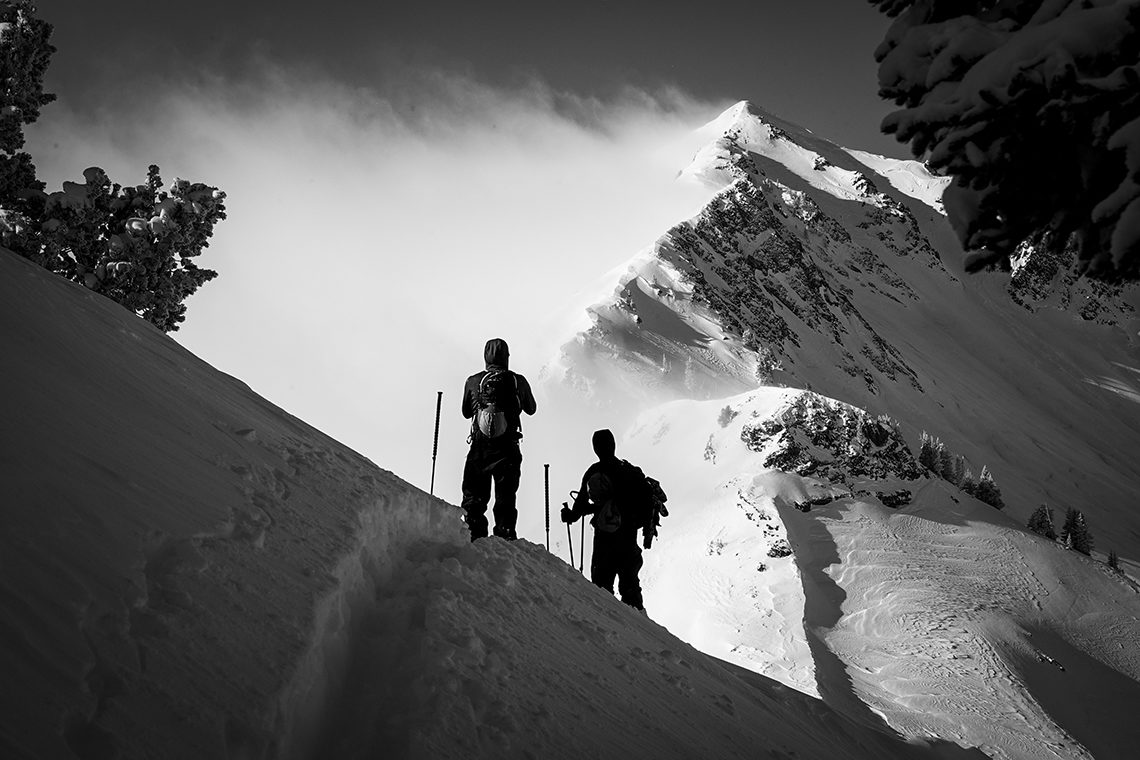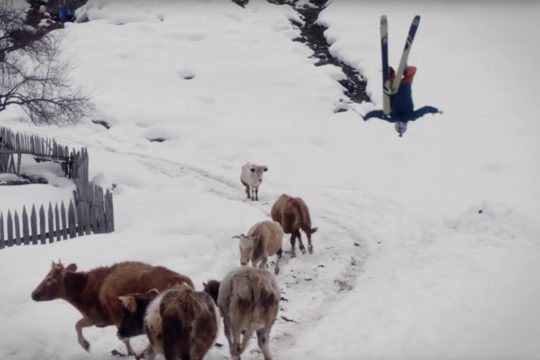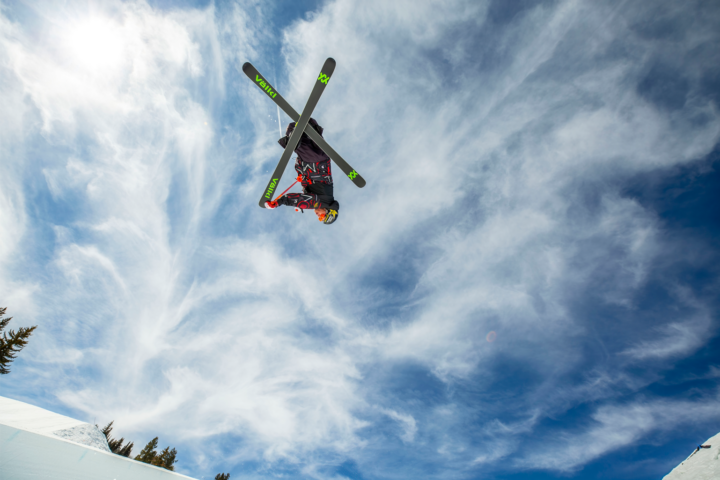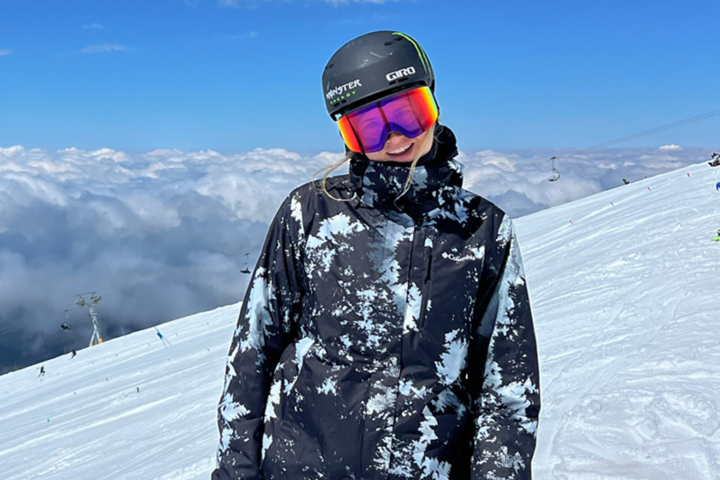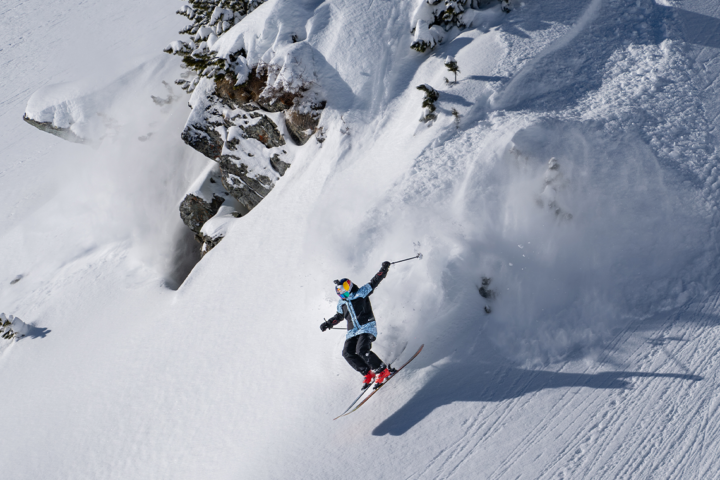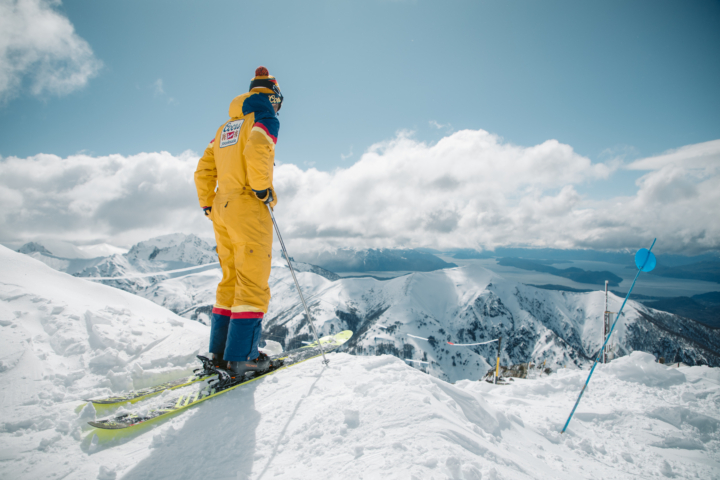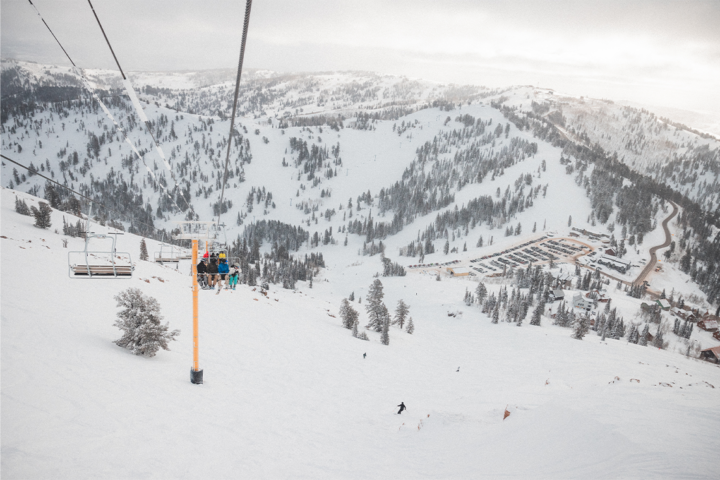Cody Townsend is one of the most recognizable names in skiing at the moment. He’s been a regular in Matchstick Productions’ annual flicks since 2005’s The Hit List, has wowed mass audiences with his fast, fluid approach to big-mountain skiing and won over the hearts of ski enthusiasts the world over with his low-key demeanor and charisma. Last week, he announced his most ambitious project to date, the goal to ski all fifty lines in the beloved book, 50 Classic Ski Descents of North America, by Chris Davenport, Art Burrows and Penn Newhard.
This coffee table book is cherished by skiers across the continent. I myself have spent countless hours with my nose stuck in the book, just imagining the possibilities that exist with these ski descents. I’ve only managed to attempt and complete one of them, the Silver Couloir on Buffalo Mountain in Summit County, Colorado… Cody plans on tackling all of them over the next three years. He’s skied a few already, including the Messner Couloir on Denali, which is featured in episode one of the series accompanying the project. The Santa Cruz, California native has enlisted veteran filmmaker Bjarne Salén to document the series, which is sure to translate to an incredible collection of videos when it’s all said and done. Naturally, we had to ring Townsend on his way out of Utah to really shed light on what is in store for him in the coming seasons.
The Interview
Hey Cody!
Hey, how’s it goin’?
Things are good, it’s dumping snow here in Denver, and the mountains are getting the brunt of it, which is great.
Yeah, it seems to be hammering everywhere this winter, pretty much. Pretty much everywhere is doing well, which is the first time in like a decade I feel like.
Where are you right now, still in Utah?
Yeah, I’m in Park City, heading out to Elko, Nevada.
That’s great. Well, regarding the announcement of your project, the reception has been pretty tremendous. A lot of people have this book, and a lot of people love the book, so seeing someone go after all of the lines in it has resonated with a lot of folks. When did you first get your hands on a copy of it?
Yeah, I think I got it right when it came out because Dav [Chris Davenport] sent me a copy because I actually have some pictures in the book. At the time, I thought that was pretty laughable because I had pretty much only had one line that I had ever hiked and skied before in my life, and it was the one line that ended up being in there. I will say, when I first got it, I was just like, “eh, cool,” but it didn’t really strike me the way it does today, because I think my mindset just wasn’t in that place.
It’s funny you say that because I think many people have noticed that you’ve transitioned more towards technical ski mountaineering from the typical powder and pillows audiences were used to. I’m sure deep pillow skiing is still pretty high on your list, but this seems to be a new love. Can you talk about that evolution?
It’s definitely been an evolution. I’ve been primarily focused on freeride skiing for sixteen years now. For me, I almost started to lose the challenge that I had with it, the exploratory nature and the whole mindset of, “this is new, this is fresh, this is amazing.” And I started hiking a bit more, going for bigger adventures and skiing bigger lines and started realizing how much fun I was having doing that. Then that just evolved into this project. That’s one of the most beautiful parts of skiing, to me, the massive amounts of ways that you can do it. You can continually challenge yourself, have new, fresh ways to do it. Just the fact that in 16 years as a pro skier, and I’ve been skiing my entire life, too, all of a sudden there’s this whole new lifetime of skiing in front of me, and that’s just because I started skiing big lines via hiking.
Can you pinpoint a lightbulb moment where the project clicked in your head?
Yeah, there was one, but it was a slow flicker to get there. It really all started when I started looking at the book and focusing on one line, University Peak [in the Sierra Nevada, California] and I was like, “man, I really want to ski that one day, let’s put it on the bucket list.” And I kept doing more adventures, traveling and doing more human-powered skiing, and I looked at more of the lines and said, “Oh, let’s throw those on the bucket list, too.” It just dawned on me as the list went from one line to three lines to ten lines to fifteen, I was like, “maybe I should just try all of them because that would be really cool.”
None of the lines in this book suck, they’re all cool in their own unique way, and I wrestled back and forth for quite a long time, trying to even think, “could I do this? Is this doable? A lot of these lines are on the easier side for me, but there are a few that are super gnarly. Are you willing to put yourself in that sort of risky [situation] and claim that you’re going to attempt all fifty and go for it?” And I managed to get comfortable with that thought and figured out mentally how I would approach this whole thing, and I decided about a year ago that I was going to do this. It was about a year in the making to put it all together.
You’ve skied the Messner on Denali, and I’m currently looking at your photo in the book of you skiing Terminal Cancer, in Nevada, I’m assuming that’s where you’re going right now.
Yep, sure is.
Are you repeating certain ones for a reason? You had mentioned that you will not be doing the Messner again.
I’ve skied more than a couple of them, maybe five or six. The reasons I’m repeating them are one, they’re on the easier side, Terminal Cancer, Mount Superior, I don’t have to get incredibly lucky for them and they’re skied often.
And second, they’re really fun lines and I’d like to go do them again. At the beginning of the project I said, let’s go do these again and film them, it’ll be fun. And I’ve skied Terminal Cancer like five times, I’ve been going to Elko since I was like 18, and every time it’s really fun. But this next episode, the next time I ski it, which is hopefully [January 25] there’s going to be a little bit of a twist. You’ll have to tune in.
A lot of these lines are straightforward, relatively speaking, are there any that you have a heightened awareness about?
To me, there are many lines that are very straightforward and well within my capabilities. They just need the right conditions and [my group] needs to feel good about them. There are about ten lines that will be challenging in a unique way and seven of the ones that are going to be even more difficult to line up.
Then, there are three lines that are the crux. The crux ones take up the majority of my brainpower, though I can’t allow myself to let my guard down on the rest of them. Because, ultimately, they all still are big backcountry lines and have consequences if you make mistakes. The three lines are the ones that keep me up at night, it’s the other ones I still have to be focused on.
Mount Robson looks like a burly one.
Robson is one of the burlier ones; the three cruxes to me are University Peak, the North Face of Mount Robson [British Columbia] and Mount St. Elias [Alaska]. They’re incredibly difficult and all need perfect things to line up and they won’t get skied unless there are perfect conditions. I will need luck on my side for sure. But, I will also need a lot of other things, really good decision making, really good partners, really good mental state and ultimately, patience.
 Townsend, doing his best crusty ski mountaineer impression.
Townsend, doing his best crusty ski mountaineer impression. You mentioned partners. I saw that you went out and skied Mt. Superior in Utah with Pep Fujas, Joe Johnson (Salomon Outdoor Marketing Manager) and Weston Shirey (local photographer). What’s your plan in terms of the partners you’re going to ski these lines with? Is it an ever-changing rotation?
For most of the project, I want to be meeting up with locals, local pros, local heroes, people who are part of the scene, because I think it will add something to the series. I think it’s really cool to go out with locals, and also great on the safety side because you’re skiing with people who ski the local mountains every day and know the routes a little bit better than I would, too. Then, as it gets to the more challenging lines, I’m probably going to be skiing with people I know and trust and have skied with in the past; people that have a similar mindset to me and have similar skillsets, most likely better skillsets than I do, that I can link up with along the way.
You mention linking up with local heroes along the way, what about the ski places that you never really would’ve imagined visintg? Or at least not gone out of your way to visit? Places like New Hampshire, for example. Do you have any regions you look forward to visiting that you aren’t as familiar with?
That’s honestly a big part of why I’m doing this, because I couldn’t find an excuse to go to Mt. Washington and ski Tuckerman’s, even though I’ve wanted to do it for more than a decade because it looks fun, it has an amazing scene, and this project gives me an excuse. The same goes for southern Utah to ski Mt. Tukuhnikivatz, we don’t film in these zones. And I get to go spend time in Grand Teton National Park in the spring, hopefully, and I’ve never skied there. So, it’s like, a giant excuse to go on a bunch of really cool adventures and explore North America like I haven’t really done before.
You mention that you don’t film in those kinds of places. This project is a large time commitment; are you still going to be able to balance your regular filming schedule with the project?
No, I’m pretty much just focused on this project. When I started thinking about the project a few years ago, I thought, “man, maybe I can just start ticking these off on the side and still be filming.” Then I skied Denali, and I was like, “well that was the only one I got this year.” I realized that it wouldn’t work to just do them on the side; if I really want to do this and do it safely, I have to make a full-time commitment. So I pulled back on just about every normal thing I have done over the last fifteen years and am focusing 100 percent on this.
In a recent social post you put up, you mention how grateful you are for the outpouring of support from the overarching ski community. Can you delve into the response you’ve gotten?
It’s been kind of overwhelming and surreal. It’s a realization of how tight-knit the ski community is, because of the huge number of people that have messaged me, sent me emails, just saying “Let me know how I can help, I live in Montana next to this line and can help,” and this massive network of people across North America have reached out and asked how they can help, and a lot of them are going to help. I got a call from the Whistler Ski Patrol, for example, and they were like, “hey, if you guys need any help, we’re here to help you, whether it’s snow observations, or early ups, whatever,” and that’s huge. I do need a network of people across the country because I can do my observations online and see where it’s good and stable, but having people to help me out is huge. It’s been really cool.
How do you plan on linking up all of these descents? Different lines will call for different conditions to ski, of course, mapping all of that out must be pretty intense.
What I tried to do was look at it like, what lines are doable in January? What lines are doable in February, March, April and May? So I organized the lines according to that because I have to have options. So, in January, most of these lines aren’t doable, at all. That’s because they need more snow or spring style snow or better stability that’s not there in early winter. So, I had to figure out which ones were doable first in January. Most of the lines will be in the spring, my spring will be pretty crazy, as the majority of them are big, springtime lines.
Yeah, knowing Colorado’s snowpack, we generally don’t even touch those big lines until April or May, it’s fascinating to see how you’ll go about it.
In Colorado, I can’t even think about it until April or most likely May. But this spring, I have to look at all of the other spring-only lines as much as possible, too. I’ll have to find out where the conditions are good and maybe hope Colorado is good next year or vice versa.
What gear are you relying on for this trip? I know you just announced a new touring-specific sock with Le Bent.
I’m really stoked on the Le Send sock from Le Bent. It’s perfect timing to come out with a ski touring sock, considering that’s all I’m going to be doing for the next three years.
For skis, I’m pretty much going to be between two lines of Salomon skis. For bigger descents, not the biggest lines, but most of them I will rely on the MTN Lab Boot, the MTN Binding and occasionally the Shift for when I want to ski fast, charge hard, and the QST line of skis. Those are primarily what I’ll be doing most of the skiing on. But then, when it comes to the biggest stuff, I’ll be drawing from Salomon’s true ski mountaineering line, the S/Lab Ski and S/Lab Boot, which is as light as a tennis shoe, just some of their super lightweight products there.
Then, Mammut for airbag packs is who I’m using now, their backpacks, in general, are great. Hestra probably has the most diverse line of gloves on the market, so I pretty much have a glove for every condition, which is really nice, from warm spring touring to sub-arctic conditions, at least I know my hands will be warm and protected. Nice to have your hands warm when you’re stuffing them in the snow climbing up something for hours on end.
What about training? Have you been prepping physically for this, are you sort of working yourself into tip-top ski mountaineering shape or are you just physically ready for this kind of stuff all the time?
I’m pretty much skiing myself into shape. Luckily, a lot of the early season lines aren’t the biggest ones, so I’m skiing myself into shape and touring every day, as much as possible to get ready for the bigger lines that will come in the spring. Unfortunately, producing this web series and getting it off the ground took up about six to eight months and took up so much time that I honestly had about zero time to train this summer, but I’m feeling good already after skiing so much the past few weeks and I feel myself getting into shape.
Appreciate you taking the time. Good luck in the first part of this project. If you happen to find yourself in Colorado for the Silver Couloir, hit me up and we can shred together.
Yeah, that’d be fun for sure, it’s on the list. I was almost going to hit it, it was looking deep and has been skied recently, but then it snowed again.
It’s a fun line, it gets a lot of traffic so there’s a bit of a scene up there which is awesome.
Yeah, it just reminds me of what this book is about, so much of the lines are really well-known, classic style lines. There are a few that are really, really tough, but it’s a good blend between super rad lines and ones that a lot of people can ski. It’s really cool.
